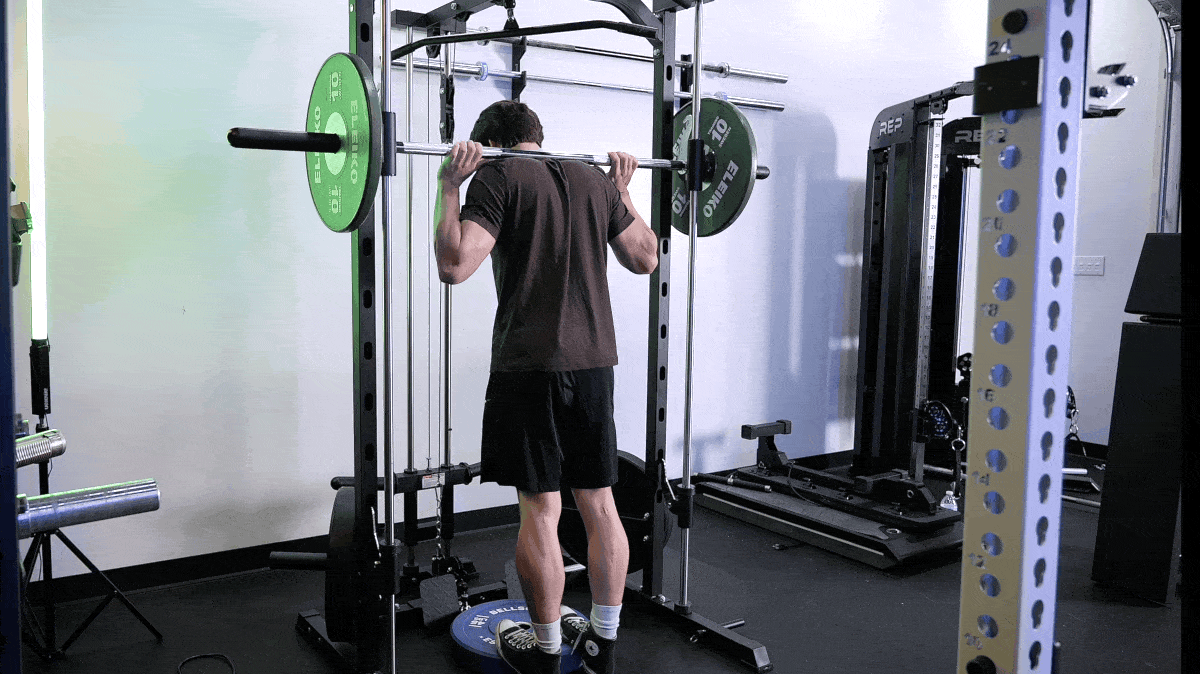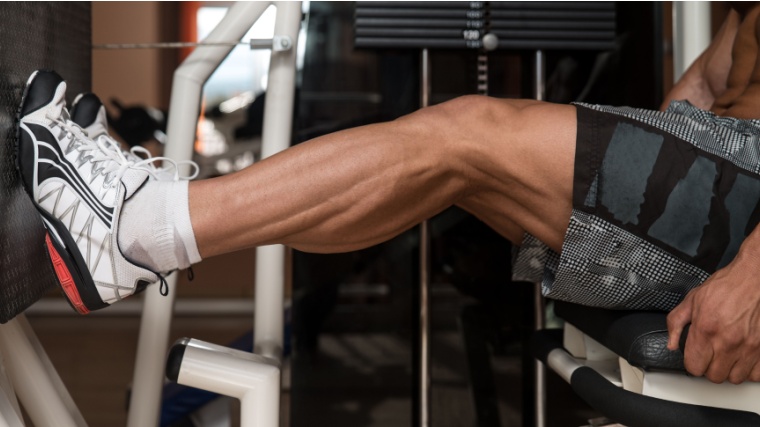I used to take an almost sick pride in skipping calves. Over the course of a decade-plus gym career, I’d find myself putting calf training on the back burner again and again. Why? Training calves is boring, plus I’d bought into the myth that calves were “up to genetics.”
- There is some evidence that your calves may not be as responsive to hypertrophy training as other muscles due to low androgen receptor density and a high proportion of type-I muscle fibers, but that’s not enough of a reason to skip calves altogether. (1)(2)
After a decade-plus career in the gym, I finally landed on a calf training protocol that is both effective and tolerable. If you want to beef up your calves in the easiest, time-savingest way possible, try what we’re dubbing the “4+1” protocol.
The 4+1 Protocol for Calf Training

The 4+1 protocol for calf training describes the range of motion you’ll use during your sets. It’s pretty simple, and I’ve personally used to it add close to an inch to my calves in 2024:
This method is both time-efficient and aligns with the leading science on calf training. Some calf workouts prescribe high rep counts, multiple calf raise variations, or more extreme intensity techniques like extended stretching — this method borrows from those ideas without requiring you to spend 20+ minutes per workout on your calves.
Despite the genetic hindrances to calf training that partially explain their “stubborn” reputation, new scientific evidence is emerging that might finally give us a leg up on calf gains.
- One study from 2023 (3) observed more than double the amount of calf hypertrophy by performing standing, straight-legged calf raises than seated calf raises.
- This finding, combined with other data (4) which argue muscles respond better to tension applied in the stretched position, lands us on the 4+1 regimen.
Put simply, the top half of a calf raise seems much less important for growth than the bottom half. Coincidentally, muscles tend to be weakest in their fully-contracted positions and stronger when they’re stretched.
The 4+1 protocol combines these findings: Cutting out the top half of the range of motion for four out of five “reps” puts more tension on your calves where you stand to gain the most muscle, and allows you to lift heavier since you don’t have to come all the way up onto your toes every time.
[Related: Best Supplements for Bodybuilding]
How To Add Calf Training To Your Workout
You can do the 4+1 protocol at any time and with nearly any equipment. That said, the best way to go about it might look something like this:
- Equipment: Use a standing calf raise machine or a leg press station. There’s no need to do seated, bent-knee calf raises here.
- Sets & Reps: 3 to 4 sets of 5 four-plus-ones with two minutes of rest between sets should take about 10 minutes total.
- Frequency: Perform this calf training workout twice per week; three times if you really believe your calves are a weak point.
- Progression: Focus on adding a small amount of weight each week. The final full-range rep of each set you perform should be extremely difficult if not impossible.
- Execution: Go slow, particularly on the eccentric, and pause at the bottom for a few seconds before hitting the full-range rep after your four partials.
If you want to ante up, after you complete all four sets, lower the weight significantly and perform a drop set of single-leg calf raises to failure with a full range of motion. Pause in the stretched position at the end for as long as you can tolerate before switching legs.
I’d strongly suggest doing your calf training at the start of your workout, not the end. Bang out your 4+1s while you’re sipping on your pre-workout — it takes 10 minutes, won’t detract from whatever weight training you’re doing after, and you’re more likely to train to failure when you’re fresh, rather than at the end of a two-hour leg day (let’s be honest, you’d skip calves and go straight home).

Have we finally cracked the code on calf training? Hardly. The 4+1 protocol doesn’t exploit a physiological loophole or change the genetic rules that make calves particularly resistant to muscle growth.
That said, it’s an easy, convenient, and most importantly sustainable way to train your calves. Calf training is a game of patience and persistence — two lessons I wish I’d learned earlier in my gym career.
More Training Content on BarBend
- 5 Big-Money Tips for More Gains on the Lat Pulldown
- The Only Two Ab Exercises You Need for a Six-Pack
- Why Bodybuilders Do Leg Curls Before Squats
References
- Dahmane, R., Djordjevic, S., Simunic, B., & Valencic, V. (2005). Spatial fiber type distribution in normal human muscle Histochemical and tensiomyographical evaluation. Journal of biomechanics, 38(12), 2451–2459.
- Seo JY, Kim JH, Kong YY. Unraveling the Paradoxical Action of Androgens on Muscle Stem Cells. Mol Cells. 2019 Feb 28;42(2):97-103. doi: 10.14348/molcells.2019.0004. Epub 2019 Feb 7. PMID: 30759971; PMCID: PMC6399011.
- Kinoshita M, Maeo S, Kobayashi Y, Eihara Y, Ono M, Sato M, Sugiyama T, Kanehisa H, Isaka T. Triceps surae muscle hypertrophy is greater after standing versus seated calf-raise training. Front Physiol. 2023 Dec 13;14:1272106. doi: 10.3389/fphys.2023.1272106. PMID: 38156065; PMCID: PMC10753835.
- Pedrosa, G. F., Lima, F. V., Schoenfeld, B. J., Lacerda, L. T., Simões, M. G., Pereira, M. R., Diniz, R. C. R., & Chagas, M. H. (2022). Partial range of motion training elicits favorable improvements in muscular adaptations when carried out at long muscle lengths. European journal of sport science, 22(8), 1250–1260.
- Binstead JT, Munjal A, Varacallo M. Anatomy, Bony Pelvis and Lower Limb: Calf. [Updated 2023 May 23]. In: StatPearls [Internet]. Treasure Island (FL): StatPearls Publishing; 2024 Jan-.
Featured Image: Jasminko Ibrakovic / Shutterstock